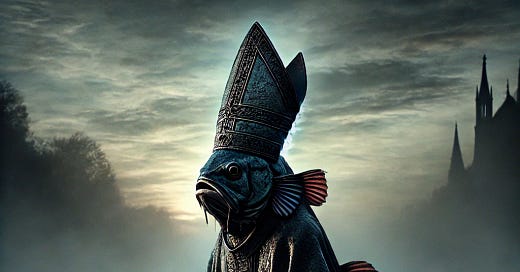Myth of the Day: Bishop-fish
In Medieval European folklore, the Bishop-fish, a human-like sea entity, symbolizes the intersection of nature, spirituality, and mystery.
Region/Culture: Europe, Central and Eastern Europe
Mythos: Medieval European Folklore
Primary Type/Nature: Monsters and Beasts
Mythical Attributes: The Bishop-fish is often depicted as a marine creature resembling a man wearing bishop’s clothing, including the mitre.
Role in Mythos: The Bishop-fish serves as a warning or curiosity tale, often used to challenge or question religious beliefs.
Relation to Humans: The creature is said to have been captured and brought before church officials, who deemed it a creature of God and set it free. This complex relationship to human authority figures often symbolizes a challenge to religious orthodoxy.
In the obscure yet captivating corners of Medieval European folklore, nestled between tales of unicorns and griffins, lies the tale of the Bishop-fish. A creature born out of the waters of Central and Eastern Europe, the Bishop-fish has long captured the imaginations of seafarers and landlubbers alike. But this is no ordinary sea beast; it is not your average denizen of the deep. Picture, if you will, a being that looks eerily like a man—clothed in the ceremonial garb of a bishop, mitre and all. If ever there were an enigma that could challenge our notions of both the natural world and spirituality, this is it.
The origin of the Bishop-fish in myth is a fascinating tapestry of layered symbolism. Medieval Europe was a cauldron of religious inquiry, and this creature emerged as an allegorical response to that quest for truth. Its very existence—so steeped in contradictions—was considered both blasphemous and revelatory. This creature arose from the depths, a maritime mystery dressed in the wardrobe of human piety, to confront a society teetering on the edge of the Age of Enlightenment.
Its tale is told as a cautionary one, often used to challenge or question the unwavering religious beliefs of the time. In one of the most intriguing stories associated with the Bishop-fish, it is said to have been captured by fishermen who, unsure of what to make of such a fantastical creature, brought it before church officials. The clergy, intrigued yet cautious, deemed the creature to be an expression of God’s infinite creativity and set it free. This is where the Bishop-fish becomes an entity of layered paradoxes—held in judgment by men in the same attire it mysteriously sports, and ultimately exonerated by the very institution it seems to question.
Let us now ponder its traits and attributes. As you can imagine, the Bishop-fish is not some undistinguished creature of the sea. It has humanoid features, dresses in episcopal clothing, and some versions even claim it carries a crozier, a staff symbolizing a shepherd’s role in the church. These adornments set the Bishop-fish apart as a unique inhabitant of the mythical bestiary. However, its powers are not well-defined in the tales. They mostly revolve around its uncanny ability to blur the lines between the earthly and the divine, the natural and the supernatural.
Yet, every intriguing story has its foil. The Bishop-fish’s weakness isn’t so much physical as it is existential. Its very form and function challenge the orthodoxy of its day, making it vulnerable to interpretation and, potentially, exploitation. Its strange existence could, at the whim of human judgment, be seen as either a divine marvel or a blasphemous aberration.
In the final reckoning, the Bishop-fish serves as an enduring symbol of the fraught relationship between humanity’s age-old traditions and the relentless push toward understanding the wider world. It stands—or swims—as a testament to the complexities of faith, the allure of the unknown, and the endless capacity for wonder in a world that, despite all our wisdom, remains a place of endless enigmas.
Suggested Further Reading
Bulfinch’s Medieval Mythology: The Age of Chivalry by Thomas Bulfinch
Creative Mythology (The Masks of God™ Book 4) by Joseph Campbell
Explore more myths and wonders by visiting godsandmonsters.info.
Enjoy mythic tales on the move with our podcast, Five Minute Mythology.





